Housing Economics: UK Market Analysis of Demand, Supply, and Subsidies
VerifiedAdded on 2023/03/23
|13
|2528
|65
Report
AI Summary
This report provides a comprehensive analysis of the UK housing market, examining key factors influencing demand, supply, and pricing. It explores the role of subsidies, both demand-side and supply-side, in shaping market dynamics and influencing consumer behavior. The report delves into the impact of income and price subsidies, comparing their effectiveness in promoting welfare within the housing sector. It also considers various factors affecting housing demand, such as population trends, income levels, interest rates, and government regulations. The analysis includes an examination of historical trends, current market conditions, and future projections. The report utilizes economic principles to explain relationships between various factors and their impact on housing prices and affordability, including the effects of elasticity and government interventions. It concludes by summarizing key findings and implications for the UK housing market, emphasizing the importance of subsidies in supporting market stability and promoting homeownership, while also acknowledging the limitations and potential drawbacks of such interventions.
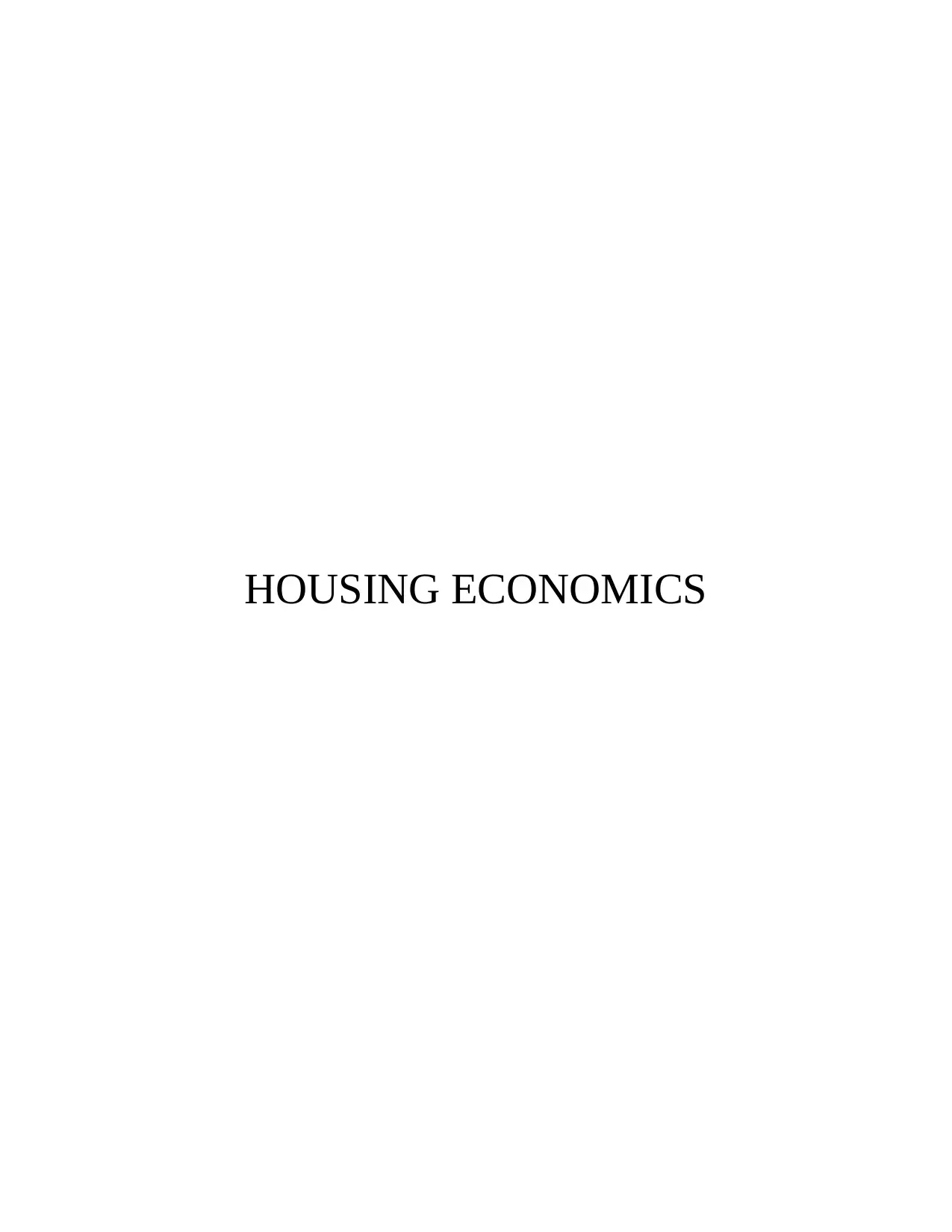
HOUSING ECONOMICS
Paraphrase This Document
Need a fresh take? Get an instant paraphrase of this document with our AI Paraphraser
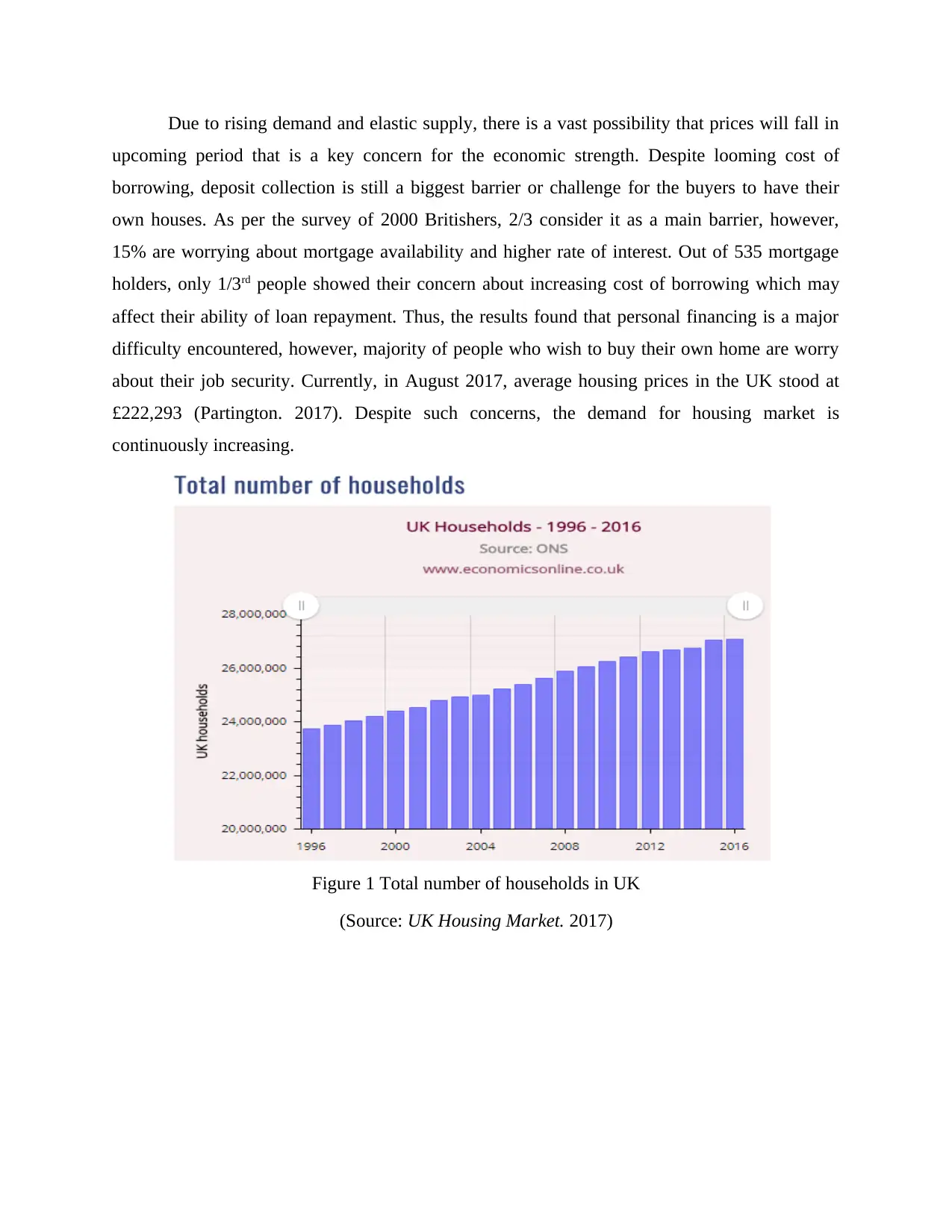
Due to rising demand and elastic supply, there is a vast possibility that prices will fall in
upcoming period that is a key concern for the economic strength. Despite looming cost of
borrowing, deposit collection is still a biggest barrier or challenge for the buyers to have their
own houses. As per the survey of 2000 Britishers, 2/3 consider it as a main barrier, however,
15% are worrying about mortgage availability and higher rate of interest. Out of 535 mortgage
holders, only 1/3rd people showed their concern about increasing cost of borrowing which may
affect their ability of loan repayment. Thus, the results found that personal financing is a major
difficulty encountered, however, majority of people who wish to buy their own home are worry
about their job security. Currently, in August 2017, average housing prices in the UK stood at
£222,293 (Partington. 2017). Despite such concerns, the demand for housing market is
continuously increasing.
Figure 1 Total number of households in UK
(Source: UK Housing Market. 2017)
upcoming period that is a key concern for the economic strength. Despite looming cost of
borrowing, deposit collection is still a biggest barrier or challenge for the buyers to have their
own houses. As per the survey of 2000 Britishers, 2/3 consider it as a main barrier, however,
15% are worrying about mortgage availability and higher rate of interest. Out of 535 mortgage
holders, only 1/3rd people showed their concern about increasing cost of borrowing which may
affect their ability of loan repayment. Thus, the results found that personal financing is a major
difficulty encountered, however, majority of people who wish to buy their own home are worry
about their job security. Currently, in August 2017, average housing prices in the UK stood at
£222,293 (Partington. 2017). Despite such concerns, the demand for housing market is
continuously increasing.
Figure 1 Total number of households in UK
(Source: UK Housing Market. 2017)
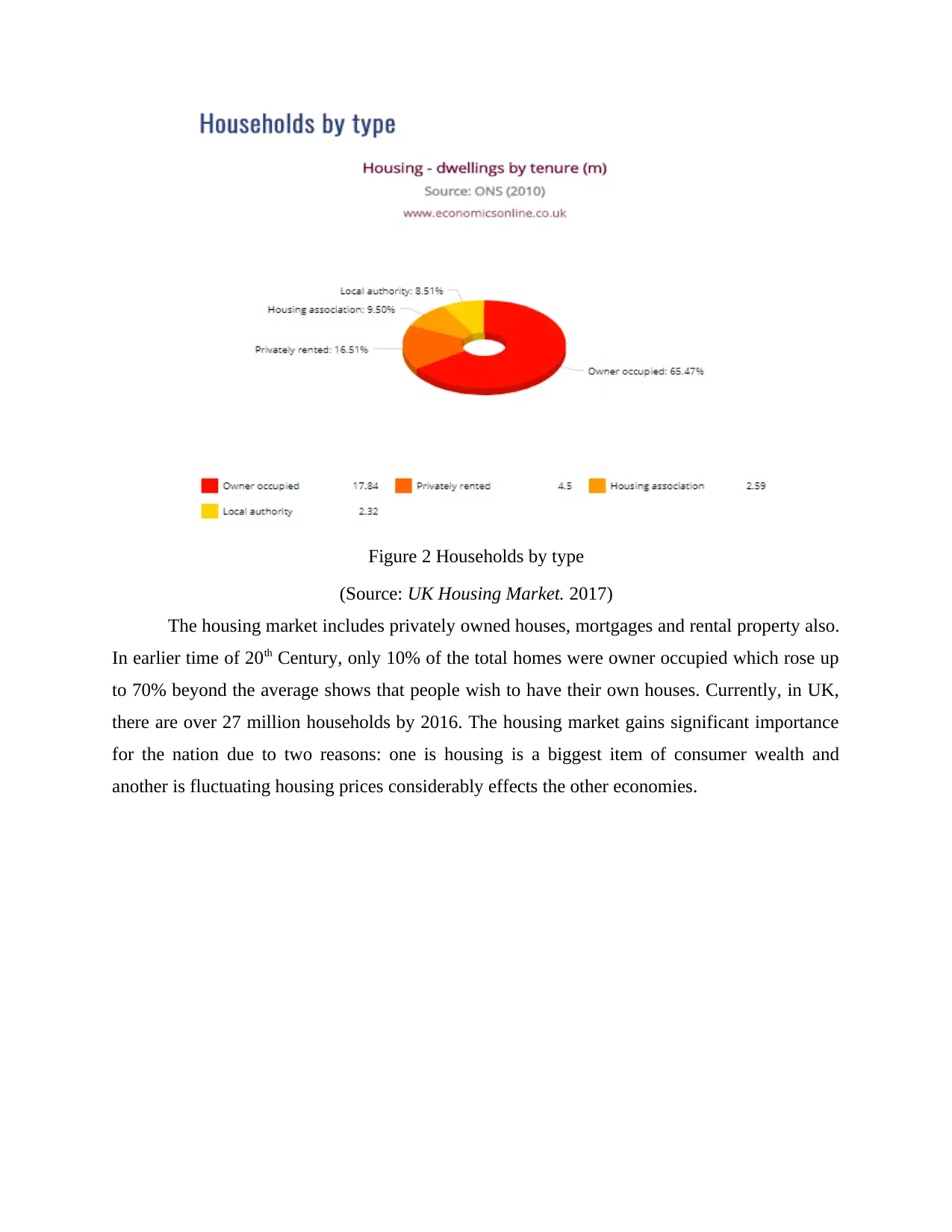
Figure 2 Households by type
(Source: UK Housing Market. 2017)
The housing market includes privately owned houses, mortgages and rental property also.
In earlier time of 20th Century, only 10% of the total homes were owner occupied which rose up
to 70% beyond the average shows that people wish to have their own houses. Currently, in UK,
there are over 27 million households by 2016. The housing market gains significant importance
for the nation due to two reasons: one is housing is a biggest item of consumer wealth and
another is fluctuating housing prices considerably effects the other economies.
(Source: UK Housing Market. 2017)
The housing market includes privately owned houses, mortgages and rental property also.
In earlier time of 20th Century, only 10% of the total homes were owner occupied which rose up
to 70% beyond the average shows that people wish to have their own houses. Currently, in UK,
there are over 27 million households by 2016. The housing market gains significant importance
for the nation due to two reasons: one is housing is a biggest item of consumer wealth and
another is fluctuating housing prices considerably effects the other economies.
⊘ This is a preview!⊘
Do you want full access?
Subscribe today to unlock all pages.

Trusted by 1+ million students worldwide
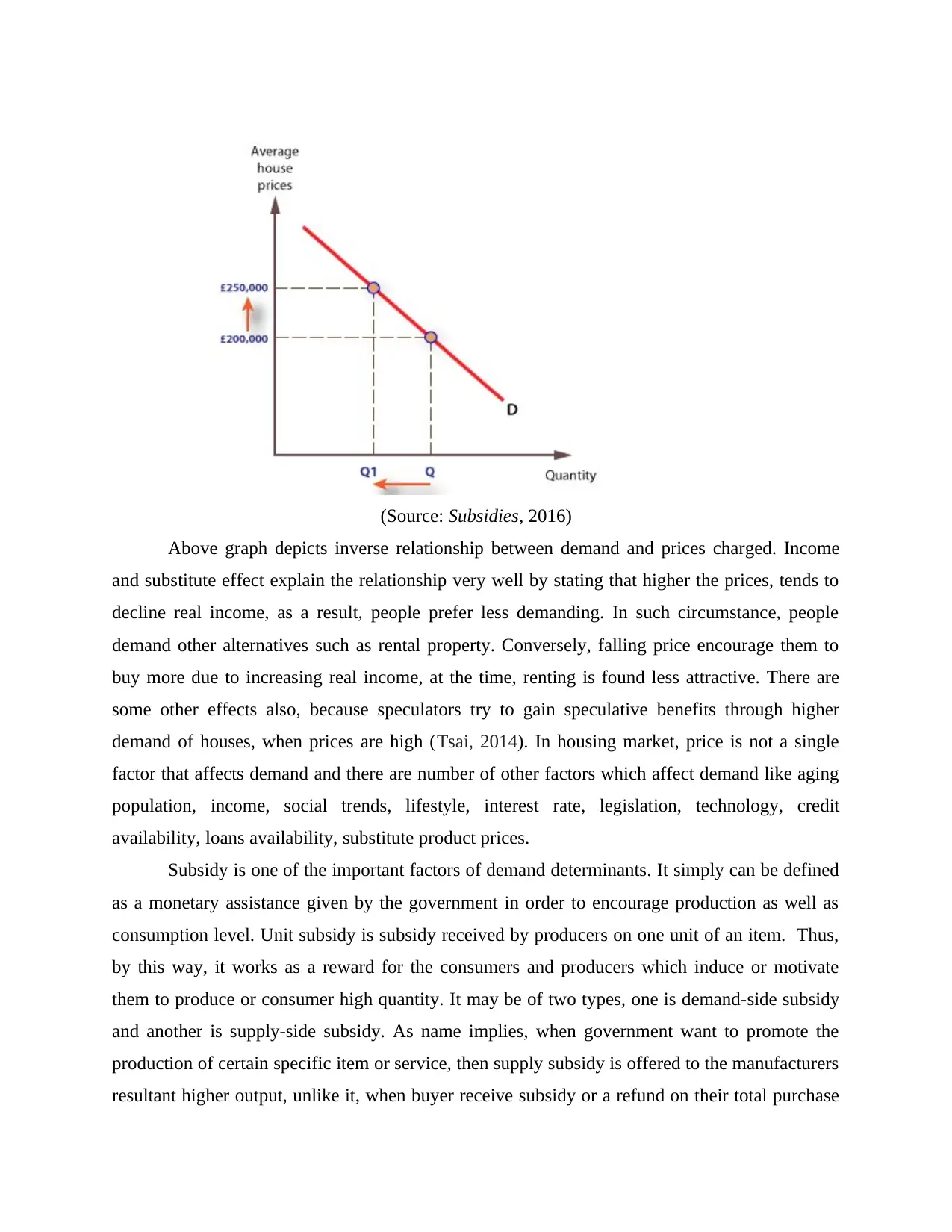
(Source: Subsidies, 2016)
Above graph depicts inverse relationship between demand and prices charged. Income
and substitute effect explain the relationship very well by stating that higher the prices, tends to
decline real income, as a result, people prefer less demanding. In such circumstance, people
demand other alternatives such as rental property. Conversely, falling price encourage them to
buy more due to increasing real income, at the time, renting is found less attractive. There are
some other effects also, because speculators try to gain speculative benefits through higher
demand of houses, when prices are high (Tsai, 2014). In housing market, price is not a single
factor that affects demand and there are number of other factors which affect demand like aging
population, income, social trends, lifestyle, interest rate, legislation, technology, credit
availability, loans availability, substitute product prices.
Subsidy is one of the important factors of demand determinants. It simply can be defined
as a monetary assistance given by the government in order to encourage production as well as
consumption level. Unit subsidy is subsidy received by producers on one unit of an item. Thus,
by this way, it works as a reward for the consumers and producers which induce or motivate
them to produce or consumer high quantity. It may be of two types, one is demand-side subsidy
and another is supply-side subsidy. As name implies, when government want to promote the
production of certain specific item or service, then supply subsidy is offered to the manufacturers
resultant higher output, unlike it, when buyer receive subsidy or a refund on their total purchase
Above graph depicts inverse relationship between demand and prices charged. Income
and substitute effect explain the relationship very well by stating that higher the prices, tends to
decline real income, as a result, people prefer less demanding. In such circumstance, people
demand other alternatives such as rental property. Conversely, falling price encourage them to
buy more due to increasing real income, at the time, renting is found less attractive. There are
some other effects also, because speculators try to gain speculative benefits through higher
demand of houses, when prices are high (Tsai, 2014). In housing market, price is not a single
factor that affects demand and there are number of other factors which affect demand like aging
population, income, social trends, lifestyle, interest rate, legislation, technology, credit
availability, loans availability, substitute product prices.
Subsidy is one of the important factors of demand determinants. It simply can be defined
as a monetary assistance given by the government in order to encourage production as well as
consumption level. Unit subsidy is subsidy received by producers on one unit of an item. Thus,
by this way, it works as a reward for the consumers and producers which induce or motivate
them to produce or consumer high quantity. It may be of two types, one is demand-side subsidy
and another is supply-side subsidy. As name implies, when government want to promote the
production of certain specific item or service, then supply subsidy is offered to the manufacturers
resultant higher output, unlike it, when buyer receive subsidy or a refund on their total purchase
Paraphrase This Document
Need a fresh take? Get an instant paraphrase of this document with our AI Paraphraser
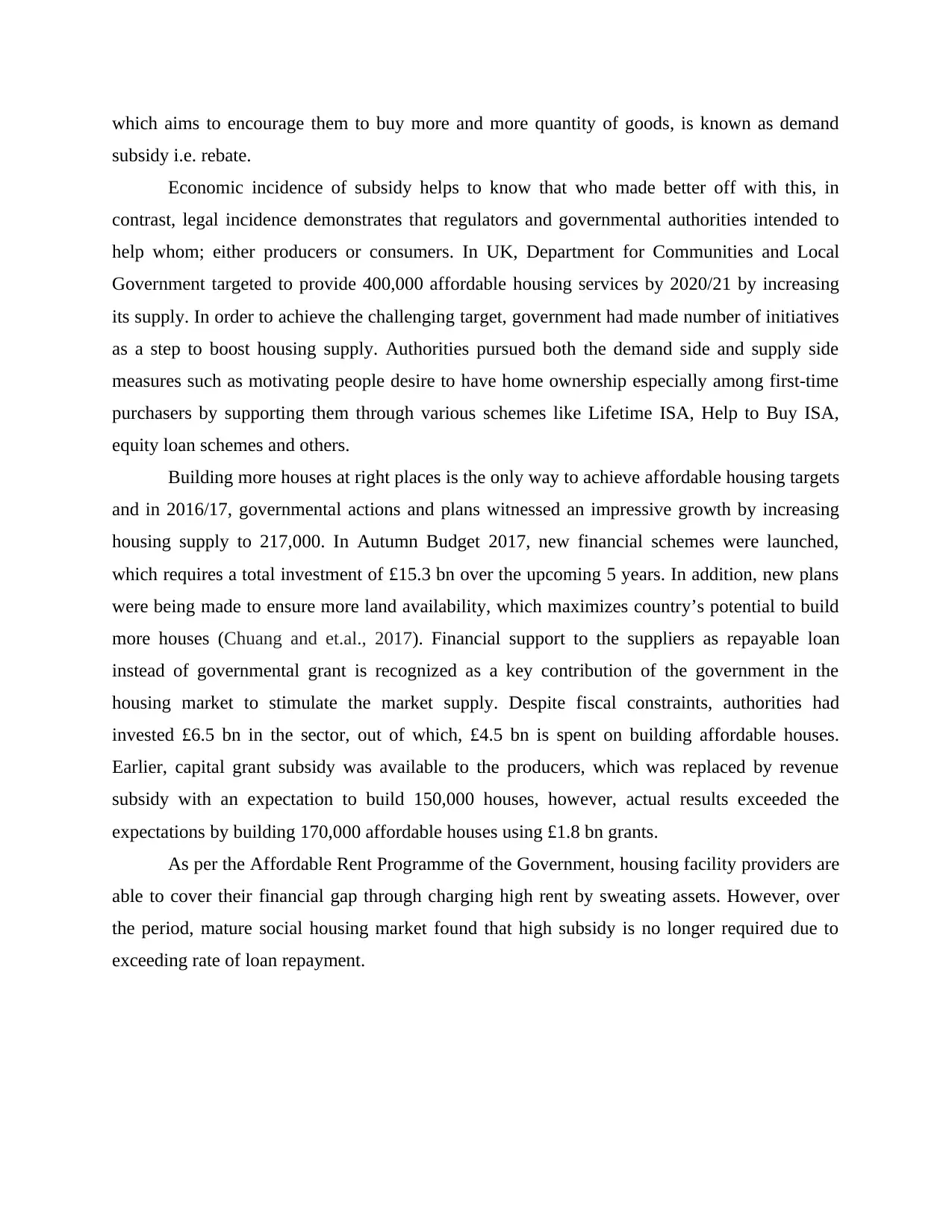
which aims to encourage them to buy more and more quantity of goods, is known as demand
subsidy i.e. rebate.
Economic incidence of subsidy helps to know that who made better off with this, in
contrast, legal incidence demonstrates that regulators and governmental authorities intended to
help whom; either producers or consumers. In UK, Department for Communities and Local
Government targeted to provide 400,000 affordable housing services by 2020/21 by increasing
its supply. In order to achieve the challenging target, government had made number of initiatives
as a step to boost housing supply. Authorities pursued both the demand side and supply side
measures such as motivating people desire to have home ownership especially among first-time
purchasers by supporting them through various schemes like Lifetime ISA, Help to Buy ISA,
equity loan schemes and others.
Building more houses at right places is the only way to achieve affordable housing targets
and in 2016/17, governmental actions and plans witnessed an impressive growth by increasing
housing supply to 217,000. In Autumn Budget 2017, new financial schemes were launched,
which requires a total investment of £15.3 bn over the upcoming 5 years. In addition, new plans
were being made to ensure more land availability, which maximizes country’s potential to build
more houses (Chuang and et.al., 2017). Financial support to the suppliers as repayable loan
instead of governmental grant is recognized as a key contribution of the government in the
housing market to stimulate the market supply. Despite fiscal constraints, authorities had
invested £6.5 bn in the sector, out of which, £4.5 bn is spent on building affordable houses.
Earlier, capital grant subsidy was available to the producers, which was replaced by revenue
subsidy with an expectation to build 150,000 houses, however, actual results exceeded the
expectations by building 170,000 affordable houses using £1.8 bn grants.
As per the Affordable Rent Programme of the Government, housing facility providers are
able to cover their financial gap through charging high rent by sweating assets. However, over
the period, mature social housing market found that high subsidy is no longer required due to
exceeding rate of loan repayment.
subsidy i.e. rebate.
Economic incidence of subsidy helps to know that who made better off with this, in
contrast, legal incidence demonstrates that regulators and governmental authorities intended to
help whom; either producers or consumers. In UK, Department for Communities and Local
Government targeted to provide 400,000 affordable housing services by 2020/21 by increasing
its supply. In order to achieve the challenging target, government had made number of initiatives
as a step to boost housing supply. Authorities pursued both the demand side and supply side
measures such as motivating people desire to have home ownership especially among first-time
purchasers by supporting them through various schemes like Lifetime ISA, Help to Buy ISA,
equity loan schemes and others.
Building more houses at right places is the only way to achieve affordable housing targets
and in 2016/17, governmental actions and plans witnessed an impressive growth by increasing
housing supply to 217,000. In Autumn Budget 2017, new financial schemes were launched,
which requires a total investment of £15.3 bn over the upcoming 5 years. In addition, new plans
were being made to ensure more land availability, which maximizes country’s potential to build
more houses (Chuang and et.al., 2017). Financial support to the suppliers as repayable loan
instead of governmental grant is recognized as a key contribution of the government in the
housing market to stimulate the market supply. Despite fiscal constraints, authorities had
invested £6.5 bn in the sector, out of which, £4.5 bn is spent on building affordable houses.
Earlier, capital grant subsidy was available to the producers, which was replaced by revenue
subsidy with an expectation to build 150,000 houses, however, actual results exceeded the
expectations by building 170,000 affordable houses using £1.8 bn grants.
As per the Affordable Rent Programme of the Government, housing facility providers are
able to cover their financial gap through charging high rent by sweating assets. However, over
the period, mature social housing market found that high subsidy is no longer required due to
exceeding rate of loan repayment.
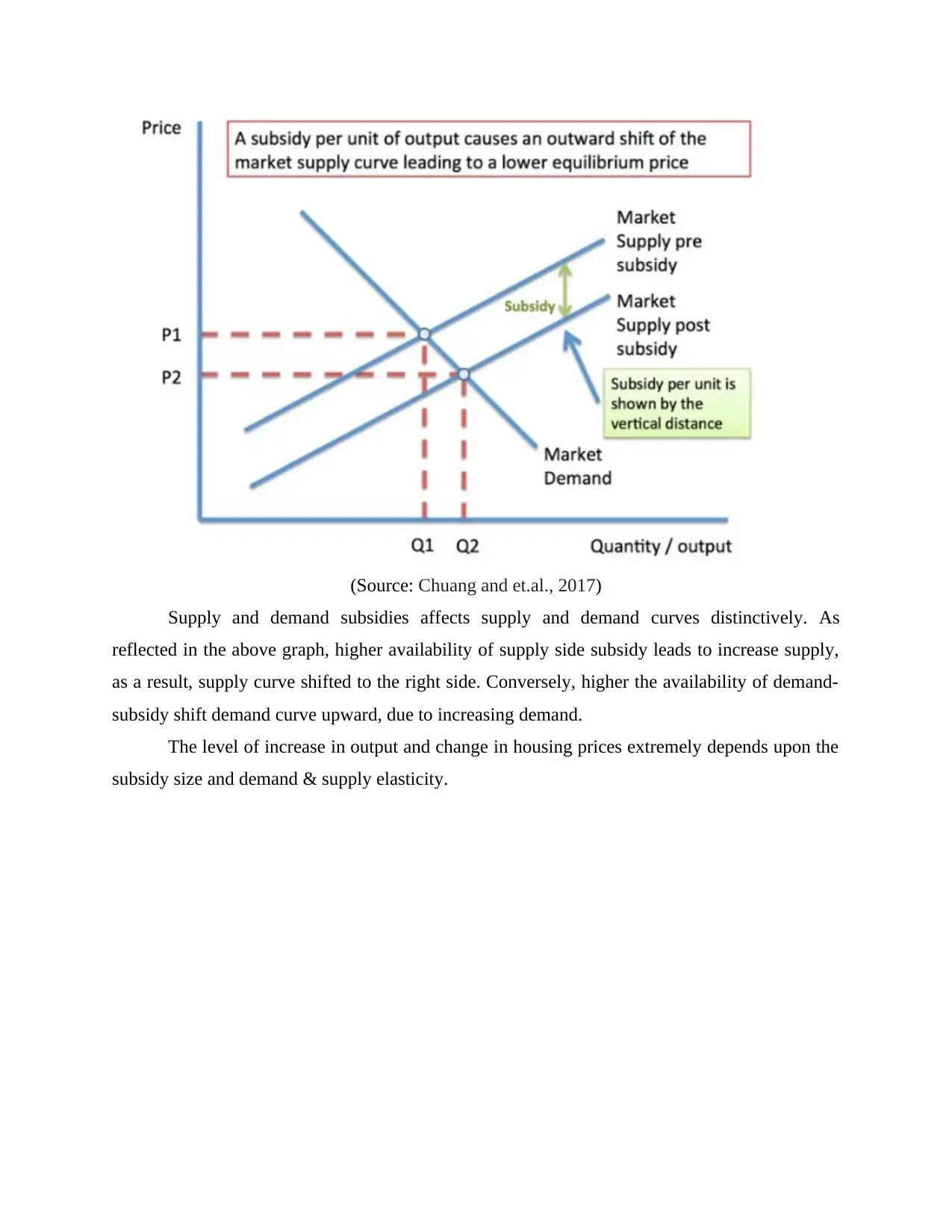
(Source: Chuang and et.al., 2017)
Supply and demand subsidies affects supply and demand curves distinctively. As
reflected in the above graph, higher availability of supply side subsidy leads to increase supply,
as a result, supply curve shifted to the right side. Conversely, higher the availability of demand-
subsidy shift demand curve upward, due to increasing demand.
The level of increase in output and change in housing prices extremely depends upon the
subsidy size and demand & supply elasticity.
Supply and demand subsidies affects supply and demand curves distinctively. As
reflected in the above graph, higher availability of supply side subsidy leads to increase supply,
as a result, supply curve shifted to the right side. Conversely, higher the availability of demand-
subsidy shift demand curve upward, due to increasing demand.
The level of increase in output and change in housing prices extremely depends upon the
subsidy size and demand & supply elasticity.
⊘ This is a preview!⊘
Do you want full access?
Subscribe today to unlock all pages.

Trusted by 1+ million students worldwide
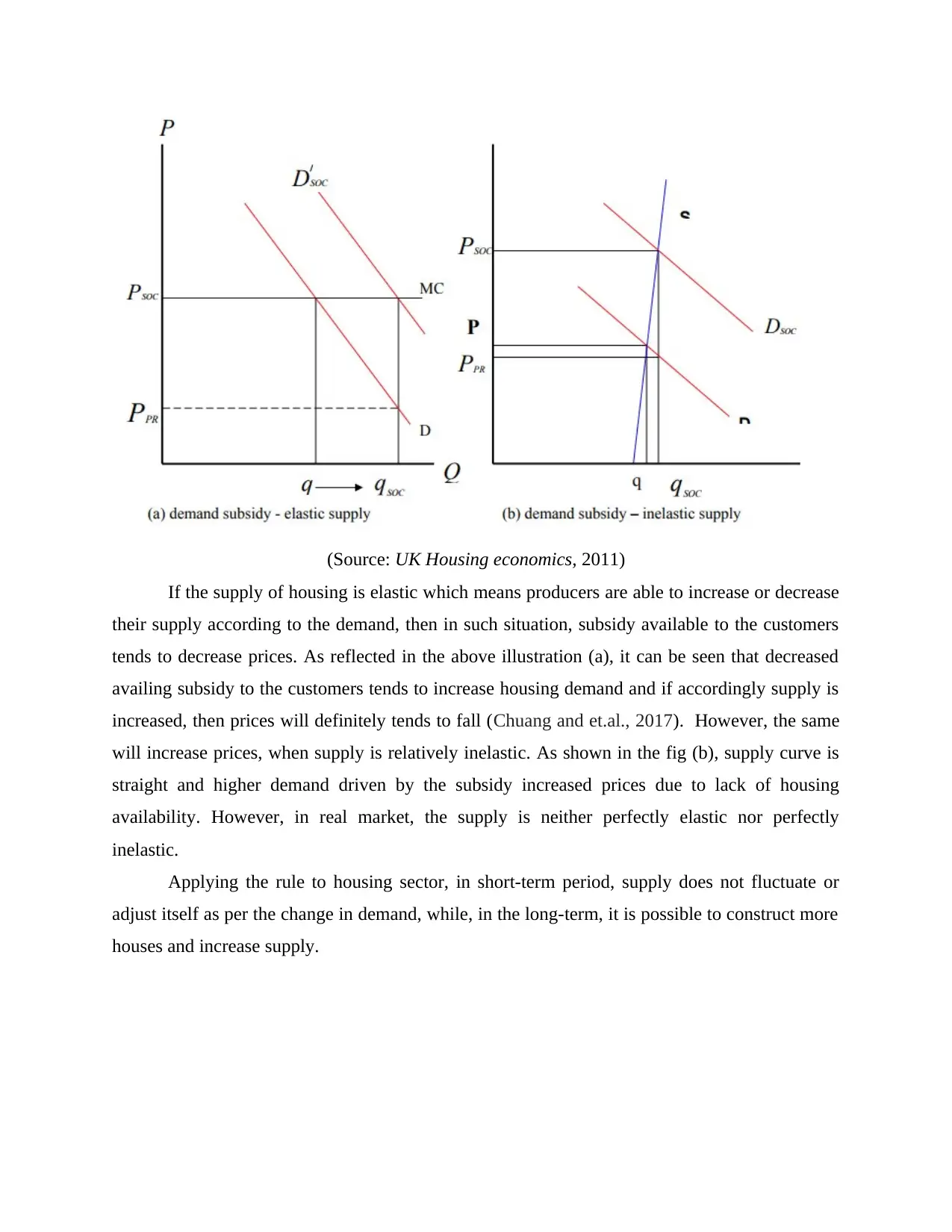
(Source: UK Housing economics, 2011)
If the supply of housing is elastic which means producers are able to increase or decrease
their supply according to the demand, then in such situation, subsidy available to the customers
tends to decrease prices. As reflected in the above illustration (a), it can be seen that decreased
availing subsidy to the customers tends to increase housing demand and if accordingly supply is
increased, then prices will definitely tends to fall (Chuang and et.al., 2017). However, the same
will increase prices, when supply is relatively inelastic. As shown in the fig (b), supply curve is
straight and higher demand driven by the subsidy increased prices due to lack of housing
availability. However, in real market, the supply is neither perfectly elastic nor perfectly
inelastic.
Applying the rule to housing sector, in short-term period, supply does not fluctuate or
adjust itself as per the change in demand, while, in the long-term, it is possible to construct more
houses and increase supply.
If the supply of housing is elastic which means producers are able to increase or decrease
their supply according to the demand, then in such situation, subsidy available to the customers
tends to decrease prices. As reflected in the above illustration (a), it can be seen that decreased
availing subsidy to the customers tends to increase housing demand and if accordingly supply is
increased, then prices will definitely tends to fall (Chuang and et.al., 2017). However, the same
will increase prices, when supply is relatively inelastic. As shown in the fig (b), supply curve is
straight and higher demand driven by the subsidy increased prices due to lack of housing
availability. However, in real market, the supply is neither perfectly elastic nor perfectly
inelastic.
Applying the rule to housing sector, in short-term period, supply does not fluctuate or
adjust itself as per the change in demand, while, in the long-term, it is possible to construct more
houses and increase supply.
Paraphrase This Document
Need a fresh take? Get an instant paraphrase of this document with our AI Paraphraser
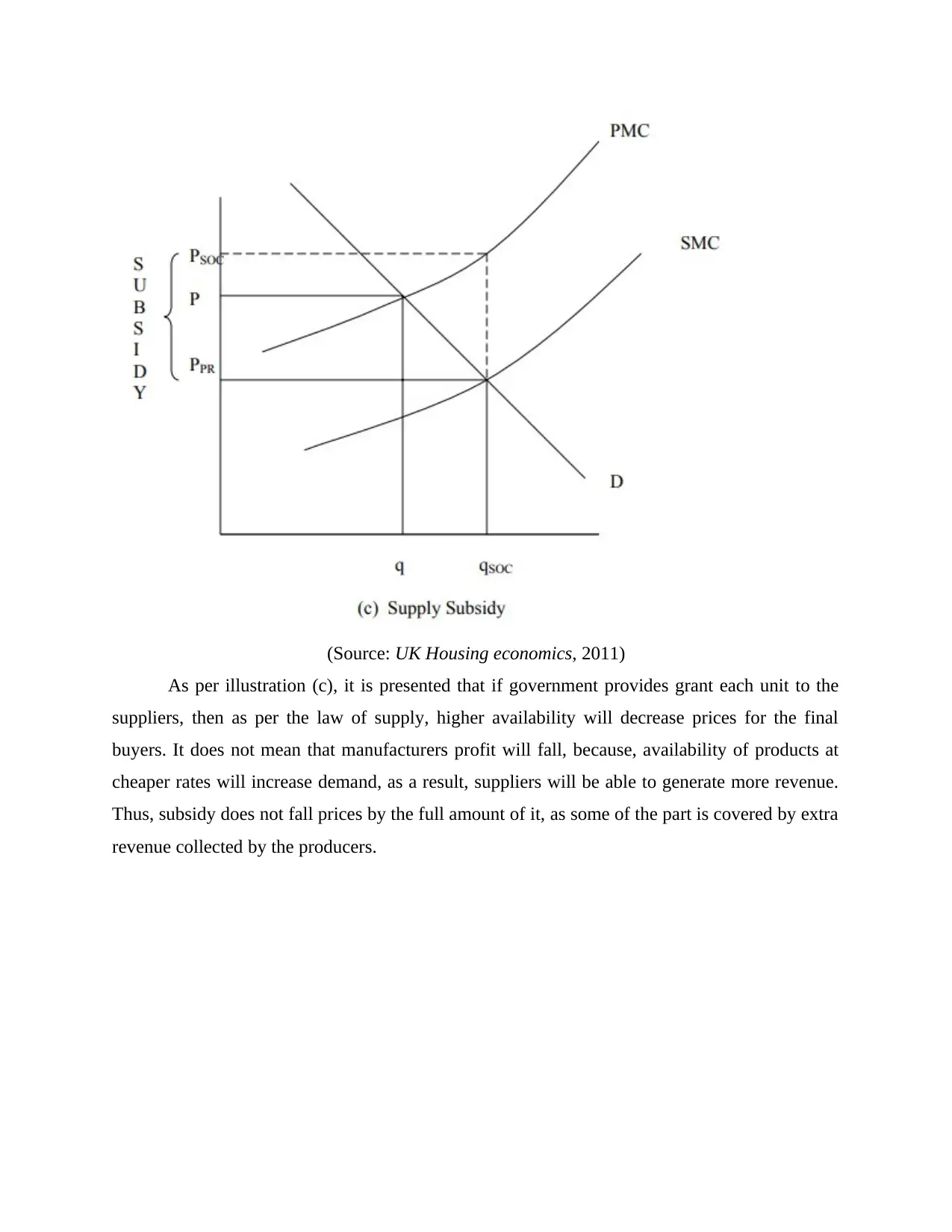
(Source: UK Housing economics, 2011)
As per illustration (c), it is presented that if government provides grant each unit to the
suppliers, then as per the law of supply, higher availability will decrease prices for the final
buyers. It does not mean that manufacturers profit will fall, because, availability of products at
cheaper rates will increase demand, as a result, suppliers will be able to generate more revenue.
Thus, subsidy does not fall prices by the full amount of it, as some of the part is covered by extra
revenue collected by the producers.
As per illustration (c), it is presented that if government provides grant each unit to the
suppliers, then as per the law of supply, higher availability will decrease prices for the final
buyers. It does not mean that manufacturers profit will fall, because, availability of products at
cheaper rates will increase demand, as a result, suppliers will be able to generate more revenue.
Thus, subsidy does not fall prices by the full amount of it, as some of the part is covered by extra
revenue collected by the producers.
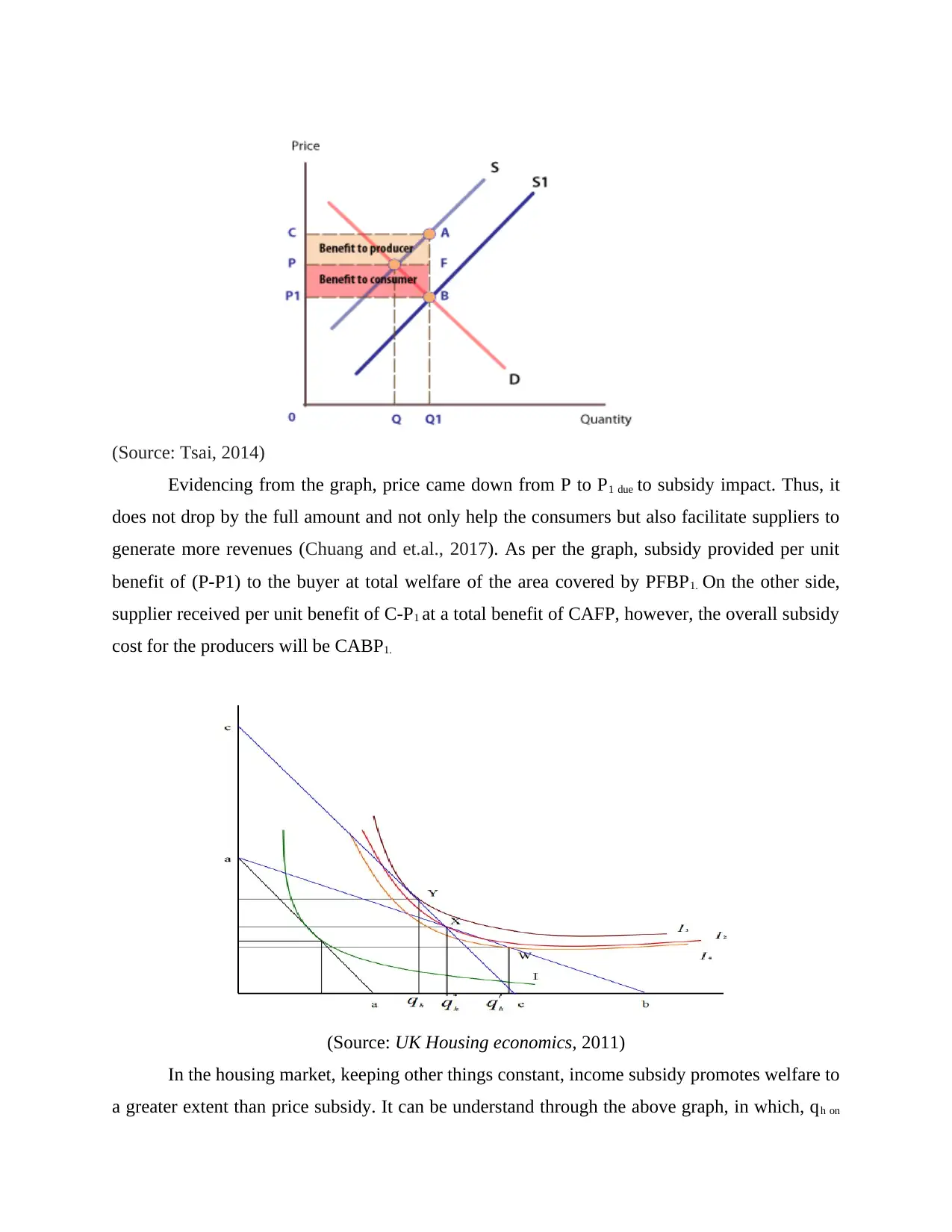
(Source: Tsai, 2014)
Evidencing from the graph, price came down from P to P1 due to subsidy impact. Thus, it
does not drop by the full amount and not only help the consumers but also facilitate suppliers to
generate more revenues (Chuang and et.al., 2017). As per the graph, subsidy provided per unit
benefit of (P-P1) to the buyer at total welfare of the area covered by PFBP1. On the other side,
supplier received per unit benefit of C-P1 at a total benefit of CAFP, however, the overall subsidy
cost for the producers will be CABP1.
(Source: UK Housing economics, 2011)
In the housing market, keeping other things constant, income subsidy promotes welfare to
a greater extent than price subsidy. It can be understand through the above graph, in which, qh on
Evidencing from the graph, price came down from P to P1 due to subsidy impact. Thus, it
does not drop by the full amount and not only help the consumers but also facilitate suppliers to
generate more revenues (Chuang and et.al., 2017). As per the graph, subsidy provided per unit
benefit of (P-P1) to the buyer at total welfare of the area covered by PFBP1. On the other side,
supplier received per unit benefit of C-P1 at a total benefit of CAFP, however, the overall subsidy
cost for the producers will be CABP1.
(Source: UK Housing economics, 2011)
In the housing market, keeping other things constant, income subsidy promotes welfare to
a greater extent than price subsidy. It can be understand through the above graph, in which, qh on
⊘ This is a preview!⊘
Do you want full access?
Subscribe today to unlock all pages.

Trusted by 1+ million students worldwide
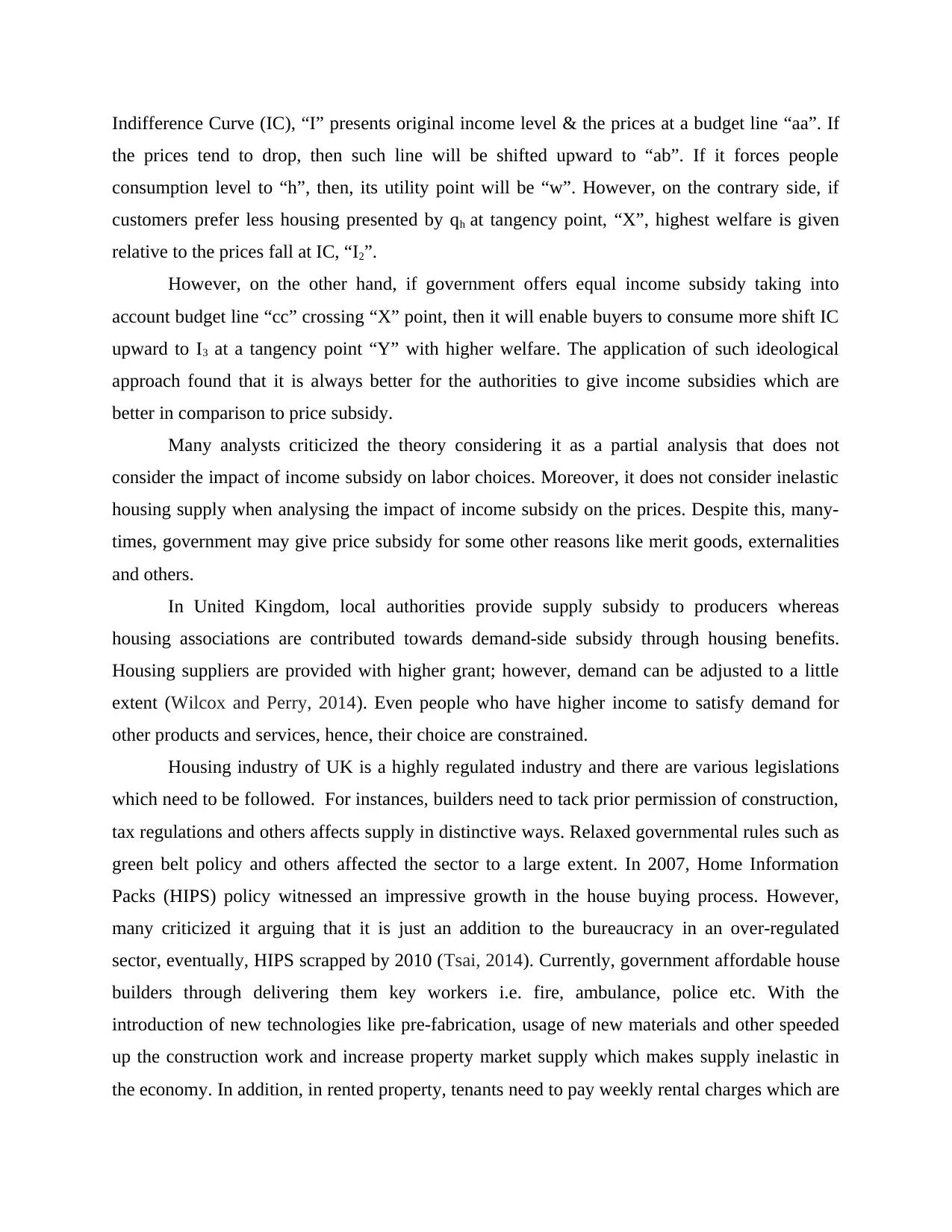
Indifference Curve (IC), “I” presents original income level & the prices at a budget line “aa”. If
the prices tend to drop, then such line will be shifted upward to “ab”. If it forces people
consumption level to “h”, then, its utility point will be “w”. However, on the contrary side, if
customers prefer less housing presented by qh at tangency point, “X”, highest welfare is given
relative to the prices fall at IC, “I2”.
However, on the other hand, if government offers equal income subsidy taking into
account budget line “cc” crossing “X” point, then it will enable buyers to consume more shift IC
upward to I3 at a tangency point “Y” with higher welfare. The application of such ideological
approach found that it is always better for the authorities to give income subsidies which are
better in comparison to price subsidy.
Many analysts criticized the theory considering it as a partial analysis that does not
consider the impact of income subsidy on labor choices. Moreover, it does not consider inelastic
housing supply when analysing the impact of income subsidy on the prices. Despite this, many-
times, government may give price subsidy for some other reasons like merit goods, externalities
and others.
In United Kingdom, local authorities provide supply subsidy to producers whereas
housing associations are contributed towards demand-side subsidy through housing benefits.
Housing suppliers are provided with higher grant; however, demand can be adjusted to a little
extent (Wilcox and Perry, 2014). Even people who have higher income to satisfy demand for
other products and services, hence, their choice are constrained.
Housing industry of UK is a highly regulated industry and there are various legislations
which need to be followed. For instances, builders need to tack prior permission of construction,
tax regulations and others affects supply in distinctive ways. Relaxed governmental rules such as
green belt policy and others affected the sector to a large extent. In 2007, Home Information
Packs (HIPS) policy witnessed an impressive growth in the house buying process. However,
many criticized it arguing that it is just an addition to the bureaucracy in an over-regulated
sector, eventually, HIPS scrapped by 2010 (Tsai, 2014). Currently, government affordable house
builders through delivering them key workers i.e. fire, ambulance, police etc. With the
introduction of new technologies like pre-fabrication, usage of new materials and other speeded
up the construction work and increase property market supply which makes supply inelastic in
the economy. In addition, in rented property, tenants need to pay weekly rental charges which are
the prices tend to drop, then such line will be shifted upward to “ab”. If it forces people
consumption level to “h”, then, its utility point will be “w”. However, on the contrary side, if
customers prefer less housing presented by qh at tangency point, “X”, highest welfare is given
relative to the prices fall at IC, “I2”.
However, on the other hand, if government offers equal income subsidy taking into
account budget line “cc” crossing “X” point, then it will enable buyers to consume more shift IC
upward to I3 at a tangency point “Y” with higher welfare. The application of such ideological
approach found that it is always better for the authorities to give income subsidies which are
better in comparison to price subsidy.
Many analysts criticized the theory considering it as a partial analysis that does not
consider the impact of income subsidy on labor choices. Moreover, it does not consider inelastic
housing supply when analysing the impact of income subsidy on the prices. Despite this, many-
times, government may give price subsidy for some other reasons like merit goods, externalities
and others.
In United Kingdom, local authorities provide supply subsidy to producers whereas
housing associations are contributed towards demand-side subsidy through housing benefits.
Housing suppliers are provided with higher grant; however, demand can be adjusted to a little
extent (Wilcox and Perry, 2014). Even people who have higher income to satisfy demand for
other products and services, hence, their choice are constrained.
Housing industry of UK is a highly regulated industry and there are various legislations
which need to be followed. For instances, builders need to tack prior permission of construction,
tax regulations and others affects supply in distinctive ways. Relaxed governmental rules such as
green belt policy and others affected the sector to a large extent. In 2007, Home Information
Packs (HIPS) policy witnessed an impressive growth in the house buying process. However,
many criticized it arguing that it is just an addition to the bureaucracy in an over-regulated
sector, eventually, HIPS scrapped by 2010 (Tsai, 2014). Currently, government affordable house
builders through delivering them key workers i.e. fire, ambulance, police etc. With the
introduction of new technologies like pre-fabrication, usage of new materials and other speeded
up the construction work and increase property market supply which makes supply inelastic in
the economy. In addition, in rented property, tenants need to pay weekly rental charges which are
Paraphrase This Document
Need a fresh take? Get an instant paraphrase of this document with our AI Paraphraser

subsidized by setting charges below the commercial rates. It is not just set considering
individual’s ability to pay by measuring their income but also consider their housing need.
CONCLUSION
From the analysis, it is found that housing sector of UK is growing as people now
desiring for having their own houses. However, inflation, possibility of increasing cost of
borrowing and personal financing were discovered as a major barrier for the people to buy their
homes. Despite such concerns, demand for the housing market shows rapid increase. In the
sector, price is not a single element of demand but also there are multitude of non-price
determinates and subsidy is one of the important factors which mainly aim to boost production
and consumption level. The report found that subsidy has a strong influence over demand and
supply curve. It is because, supply subsidies encourage marketers to build more houses which
shifts supply curve rightward without any change in the demand. In contrast, demand subsidies
like tax rebate, subsidized rent and others motivate buyers to consume more which shifted
demand curve to the right side. However, the thorough analysis of housing market found that
subsidy size and elasticity of supply has a mutual impact on the prices as a result of subsidy
available. Besides this, income subsidy is discovered as a better way of welfare comparison to
the price subsidy.
individual’s ability to pay by measuring their income but also consider their housing need.
CONCLUSION
From the analysis, it is found that housing sector of UK is growing as people now
desiring for having their own houses. However, inflation, possibility of increasing cost of
borrowing and personal financing were discovered as a major barrier for the people to buy their
homes. Despite such concerns, demand for the housing market shows rapid increase. In the
sector, price is not a single element of demand but also there are multitude of non-price
determinates and subsidy is one of the important factors which mainly aim to boost production
and consumption level. The report found that subsidy has a strong influence over demand and
supply curve. It is because, supply subsidies encourage marketers to build more houses which
shifts supply curve rightward without any change in the demand. In contrast, demand subsidies
like tax rebate, subsidized rent and others motivate buyers to consume more which shifted
demand curve to the right side. However, the thorough analysis of housing market found that
subsidy size and elasticity of supply has a mutual impact on the prices as a result of subsidy
available. Besides this, income subsidy is discovered as a better way of welfare comparison to
the price subsidy.

REFERENCES
Books and Journals
Wilcox, S. and Perry, J., 2014. UK housing review. Coventry: Chartered Institute of Housing.
Tsai, I.C., 2014. Ripple effect in house prices and trading volume in the UK housing market:
New viewpoint and evidence. Economic Modelling. 40. pp.68-75.
Chuang, M.C. and et.al., 2017. Pricing mortgage insurance contracts under housing price cycles
with jump risk: evidence from the UK housing market. The European Journal of Finance.
pp.1-38.
Online
Partington. R., 2017. Confidence in UK housing market falls to five year low. [Online]. Available
through: < https://www.theguardian.com/business/2017/oct/27/uk-housing-market-confidence-
weakens-5-year-low-house-prices>.
UK Housing Market. 2017. [Online]. Available through : <
http://www.economicsonline.co.uk/Competitive_markets/The_housing_market.html>.
Forest Time, 2016. The Effects of subsidies on the Supply and Demand Curve. [Online].
Available through: < http://smallbusiness.chron.com/effects-subsidies-supply-demand-curve-
33921.html>.
Subsidies. 2016. [Online]. Available through: <
http://www.economicsonline.co.uk/Competitive_markets/Subsidies.html>.
UK Housing economics. 2011. [PDF]. Available through: <
https://econ.lse.ac.uk/courses/sa422/sa422_govtinterventionhandout_LT2009.pdf>
Books and Journals
Wilcox, S. and Perry, J., 2014. UK housing review. Coventry: Chartered Institute of Housing.
Tsai, I.C., 2014. Ripple effect in house prices and trading volume in the UK housing market:
New viewpoint and evidence. Economic Modelling. 40. pp.68-75.
Chuang, M.C. and et.al., 2017. Pricing mortgage insurance contracts under housing price cycles
with jump risk: evidence from the UK housing market. The European Journal of Finance.
pp.1-38.
Online
Partington. R., 2017. Confidence in UK housing market falls to five year low. [Online]. Available
through: < https://www.theguardian.com/business/2017/oct/27/uk-housing-market-confidence-
weakens-5-year-low-house-prices>.
UK Housing Market. 2017. [Online]. Available through : <
http://www.economicsonline.co.uk/Competitive_markets/The_housing_market.html>.
Forest Time, 2016. The Effects of subsidies on the Supply and Demand Curve. [Online].
Available through: < http://smallbusiness.chron.com/effects-subsidies-supply-demand-curve-
33921.html>.
Subsidies. 2016. [Online]. Available through: <
http://www.economicsonline.co.uk/Competitive_markets/Subsidies.html>.
UK Housing economics. 2011. [PDF]. Available through: <
https://econ.lse.ac.uk/courses/sa422/sa422_govtinterventionhandout_LT2009.pdf>
⊘ This is a preview!⊘
Do you want full access?
Subscribe today to unlock all pages.

Trusted by 1+ million students worldwide
1 out of 13
Related Documents
Your All-in-One AI-Powered Toolkit for Academic Success.
+13062052269
info@desklib.com
Available 24*7 on WhatsApp / Email
![[object Object]](/_next/static/media/star-bottom.7253800d.svg)
Unlock your academic potential
Copyright © 2020–2026 A2Z Services. All Rights Reserved. Developed and managed by ZUCOL.




